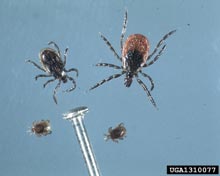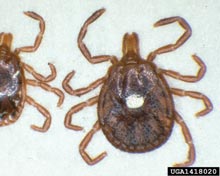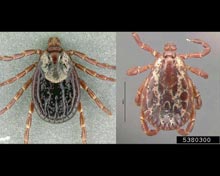
Jim Occi BugPics

Mat Pound, USDA Agricultural Research Service

Gary Alpert, Harvard University
Ticks
General Description
Although ticks are commonly thought of as insects, they are actually arachnids like scorpions, spiders and mites.
All members of this group have four pairs of legs as adults and have no antennae. Adult insects have three pairs
of legs and one pair of antennae. Ticks are among the most efficient carriers of disease because they attach
firmly when sucking blood, feed slowly and may go unnoticed for a considerable time while feeding. Ticks take
several days to complete feeding.
They have four life stages: egg, six-legged larva, eight-legged nymph and adult. After the egg hatches, the tiny larva (sometimes called a “seed tick”) feeds on an appropriate host. The larva then develops (molts) into the larger nymph. The nymph feeds on a host and then molts into an adult. Both male and female adults find and feed on a host, then the females lay eggs some time after feeding. Although at least 15 species of ticks occur in Illinois, only a few are likely to be encountered by people: the American dog tick (Dermacentor variabilis), lone star tick (Amblyomma americanum), and blacklegged (deer) tick (Ixodes scapularis).
General Control
Grass should be kept short and brush trimmed back away from structures. The best way to protect yourself
against tickborne illness is to avoid tick bites. This includes avoiding known tick-infested areas. If you enter an
area inhabited by Ticks, wear protective clothing such as long-sleeved shirts and long pants, and apply insect
repellent containing 10 percent to 30 percent DEET. Check yourself, children and pets every two to three hours
for ticks. Remove imbedded ticks promptly by gripping them with forceps (e.g., eyebrow tweezers) as close to the
skin as possible and pulling them off slowly but firmly. Wash the bite area thoroughly with soap and water and
apply an antiseptic.









